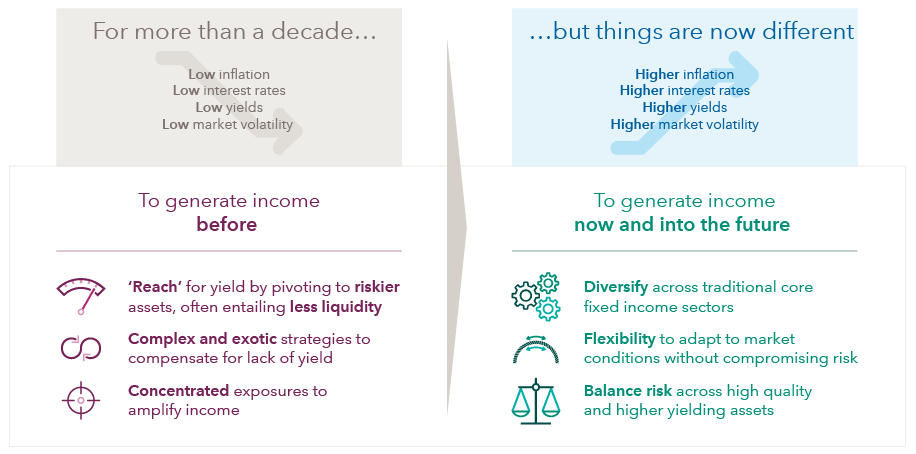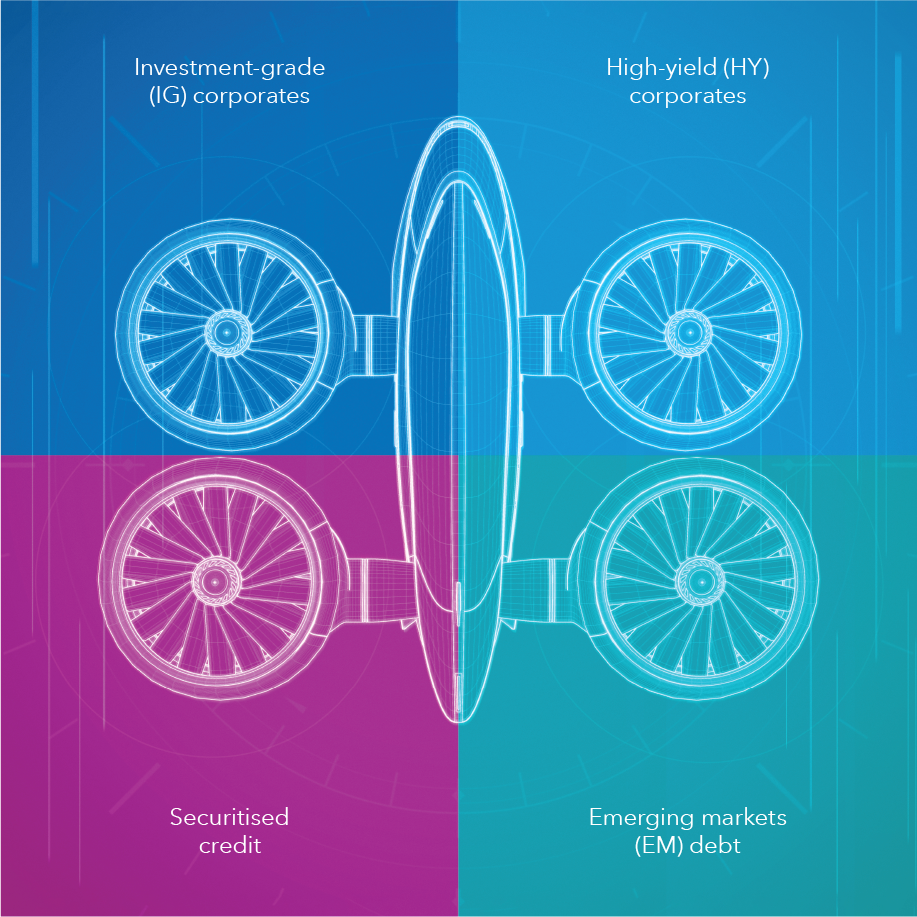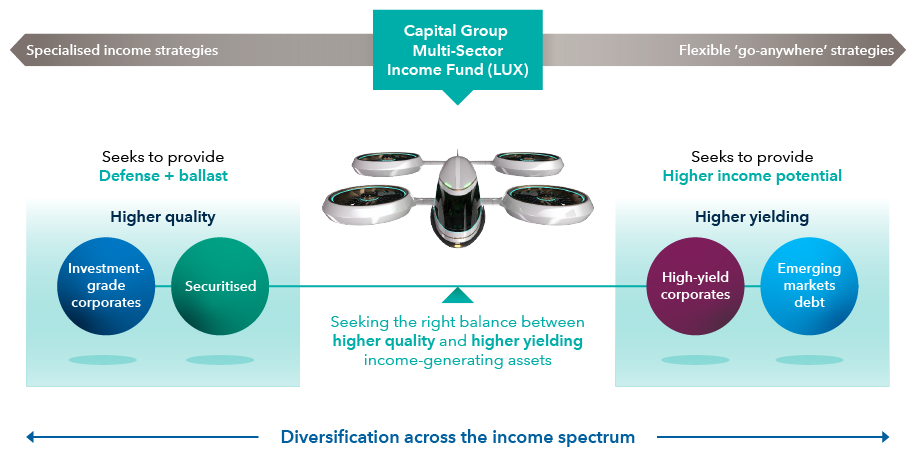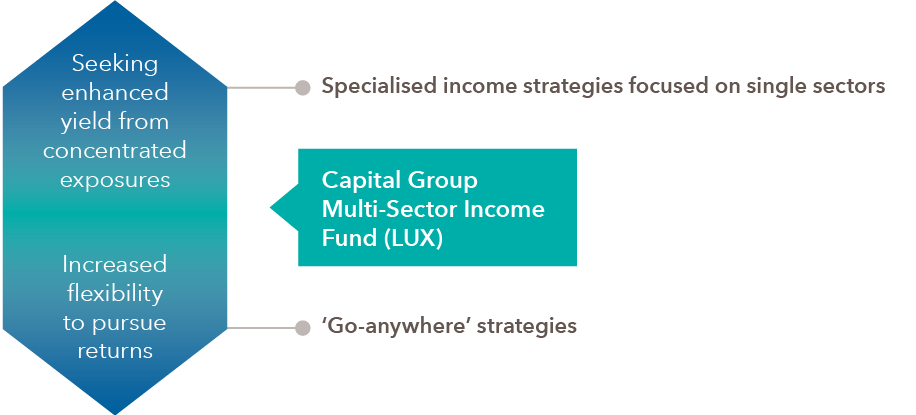OPPORTUNITIES
Income in the new investment regime
With the end of the ultra-low policy rate era and bond yields for income generating sectors at attractive levels, investors could once again derive meaningful income from a globally diversified portfolio of bonds.
-
-
Bond yields: Could history be repeating itself?
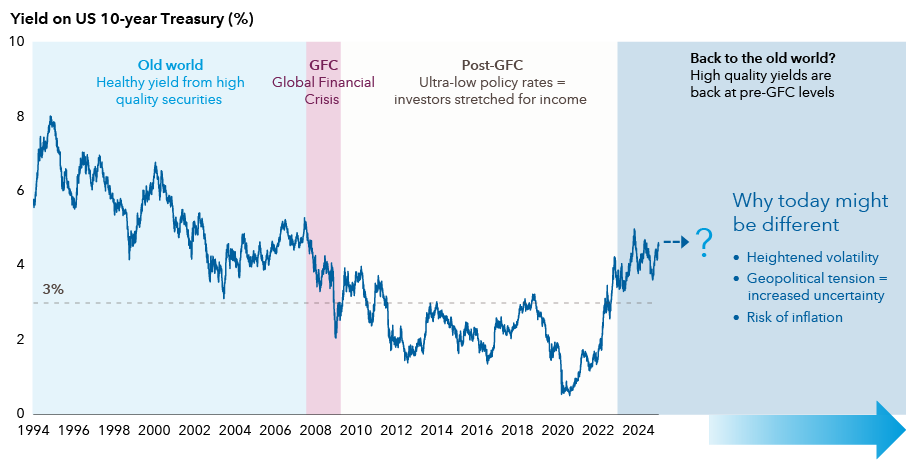
Past results are not a guarantee of future results.
-
Income generation strategies
-
THE POWER OF 4
Capital Group Multi-Sector Income Fund (LUX)
The Multi-Sector Income Fund combines the power of four key fixed income credit sectors, each of which has distinctive income characteristics. We believe that diversifying across multiple income-generating sectors and dynamically adjusting allocations to maintain a balanced risk profile could deliver a reliable income stream.
Hear from Damien McCann, Principal Investment Officer of the Multi-Sector Income Fund, on how the fund’s key characteristics of diversification, balanced, and flexibility can help deliver reliable and attractive income to investors.
ESG FOCUS
ESG integration and beyond
ESG is woven into our investment process through three tightly integrated components: investment frameworks, monitoring and engagement. The fund also applies ESG and norms-based screens and has an explicit carbon target.3
For more information on our approach, to ESG please see ESG at Capital Group.
Screens
The fund excludes issuers within certain sectors, those that violate UN Global Compact principles and sovereigns that score below the Capital Group proprietary framework’s ESG threshold.
Carbon target
The fund’s carbon footprint is also monitored and managed to be lower than its reference index (for all eligible corporate bonds in the portfolio).2,3
The fund has adopted Sustainable Finance Disclosure Regulation (SFDR) article 8 requirements. The SFDR classification is related to the EU’s regulation and is not equivalent to approval or recognition as an ESG fund by regulators in Asia Pacific.
EXPERIENCE COUNTS
Managed by an experienced and specialist team
The portfolio is managed by a Principal Investment Officer and a team of seasoned sector specialist portfolio managers. They are supported by large, dedicated investment analyst teams that help create a portfolio built on deep insights into each of the securities the fund invests in.

Damien J. McCann
Principal Investment Officer
25 years with Capital
25 years of industry experience

Shannon Ward
US high yield
8 years with Capital
32 years of industry experience

Sandro Lazzarini
US high yield
9 years with Capital
17 years of industry experience

Scott Sykes
US investment-grade corporates
19 years with Capital
24 years of industry experience

Robert Burgess
Emerging markets debt
9 years with Capital
33 years of industry experience

Xavier Goss
Securitised credit
4 years with Capital
21 years of industry experience
Years of experience as at 31st December 2024.
WHY CAPITAL GROUP
A leader in global investing
For more than 90 years, we’ve been searching the world for long-term opportunities, making Capital one of the oldest global investors. We have also grown to become one of the world’s largest active fixed income fund managers.
Global investing credentials
US$2.8T
in total assets managed
25 years
average investment experience of our fixed income portfolio managers
US$550.3B
Fixed income assets managed*
*Assets under management by Capital Fixed Income Investors.
Data as at 31 December 2024
Capital Group Multi-Sector Income Fund (LUX)
We're here with the support and solutions you need.
Don't hesitate to reach out if you have questions or need assistance.

Suyin Tan
Managing Director
Singapore & Southeast Asia
+65 6437 2655
Suyin.Tan@capitalgroup.com

Vanessa Huang
Director
Singapore & Southeast Asia
+65 6437 2790
Vanessa.Huang@capitalgroup.com

Kenneth Goh
Associate Director
Singapore & Southeast Asia
+65 6437 0430
Kenneth.Goh@capitalgroup.com

Debbie Chua
Associate Director
Singapore & Southeast Asia
+65 6437 0658
Debbie.Chua@capitalgroup.com
The information in relation to the index is provided for context and illustration only. The fund is an actively managed UCITS. It is not managed in reference to a benchmark.
Risk factors you should consider before investing:
- This material is not intended to provide investment advice or be considered a personal recommendation.
- The value of investments and income from them can go down as well as up and you may lose some or all of your initial investment.
- Past results are not a guarantee of future results.
- If the currency in which you invest strengthens against the currency in which the underlying investments of the fund are made, the value of your investment will decrease. Currency hedging seeks to limit this, but there is no guarantee that hedging will be totally successful.
- Some portfolios may invest in financial derivative instruments for investment purposes, hedging and/or efficient portfolio management.
- There are additional ABS/MBS, Bonds, Counterparty, Derivative instruments, Emerging markets, High yield bonds, Liquidity, Operational and Sustainability risks associated with this fund.
Fund risks
ABS/MBS risk: The fund may invest in mortgage- or asset-backed securities. The underlying borrowers of these securities may not be able to pay back the full amount that they owe, which may result in losses to the fund.
Bonds risk: The value of bonds can change as a result of interest rate changes – typically when interest rates rise, bond values fall. Funds investing in bonds are exposed to credit risk. A decline in the financial health of an issuer could cause the value of its bonds to fall or become worthless.
Counterparty risk: Other financial institutions provide services to the fund such as safekeeping of assets, or may serve as a counterparty to financial contracts such as derivatives. There is a risk the counterparty will not meet their obligations.
Derivative instruments risk: Derivatives are financial instruments deriving their value from an underlying asset and may be used to hedge existing exposures or to gain economic exposure. A derivative instrument may not perform as expected, may create losses greater than the cost of the derivative and may result in losses to the fund.
Emerging markets risk: Investments in emerging markets are generally more sensitive to risk events such as changes in the economic, political, fiscal and legal environment.
High yield bonds risk: Lower rated or unrated debt securities, including high yield bonds, may, as a result, be subject to liquidity, volatility, default and counterparty risk.
Liquidity risk: In stressed market conditions, certain securities held by the fund may not be able to be sold at full value, or at all. This could cause the fund to defer or suspend redemptions of its shares, meaning investors may not have immediate access to their investment.
Operational risk: The risk of potential loss resulting from inadequate or failed internal processes, people and systems or from external events.
Sustainability risk: Environmental, social or governance event or condition that, if it occurs, could cause an actual or potential material negative impact on the value of an investment of the fund.
All data as at 31 December 2023 and attributed to Capital Group, unless otherwise specified.
- Indices used to represent US high yield corporates: Bloomberg US High Yield Index 2% Issuer Cap; US investment-grade corporates: Bloomberg US Corporate Index; emerging market government bonds: JPMorgan EMBI Global Diversified Index
- Reference index: 45% Bloomberg US High Yield Index 2% Issuer Cap; 30% Bloomberg US Corporate Index; 15% JPMorgan EMBI Global Diversified Index; 8% Bloomberg CMBS Ex AAA Index; 2% Bloomberg ABS Ex AAA Index
- Carbon footprint data is based on weighted average carbon intensity

